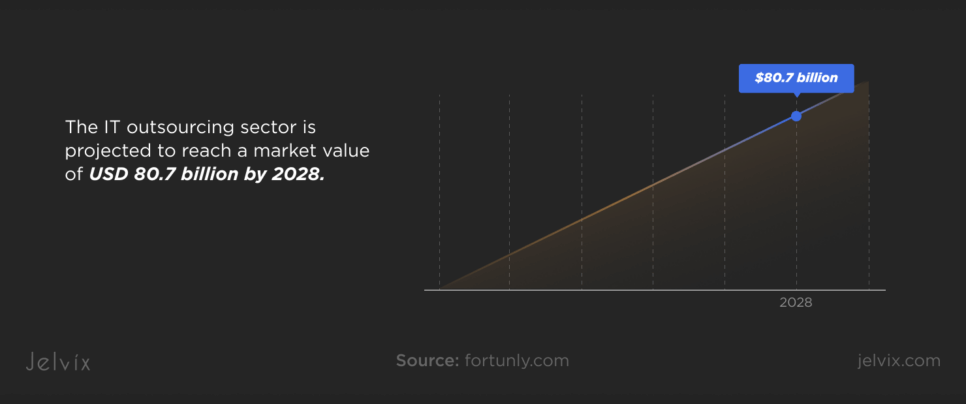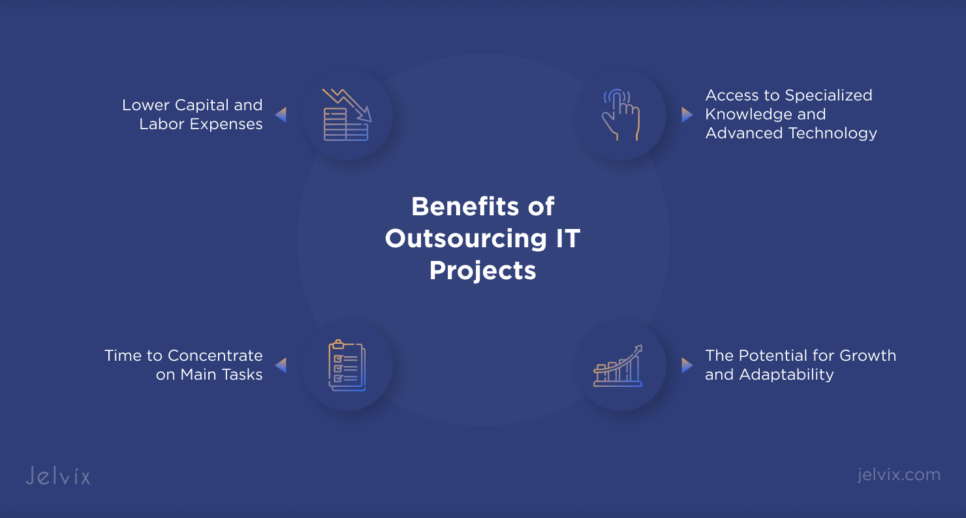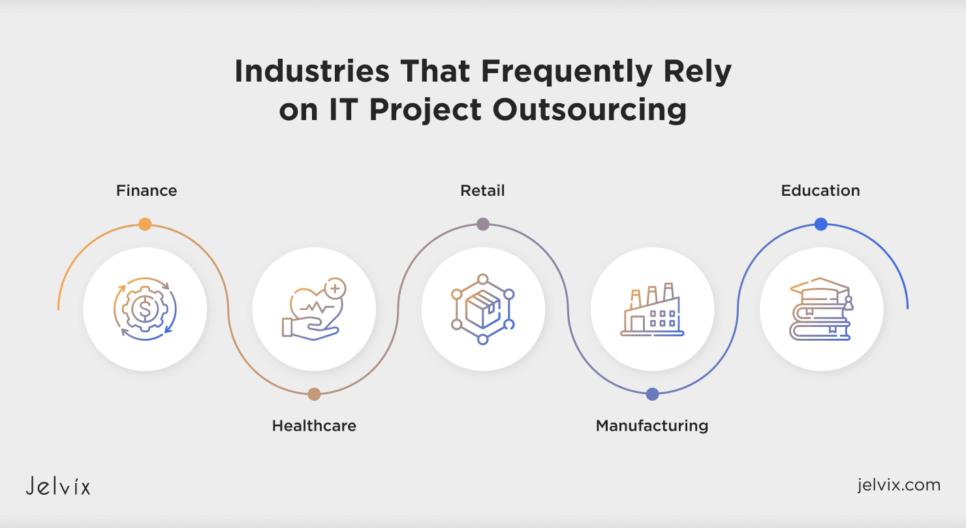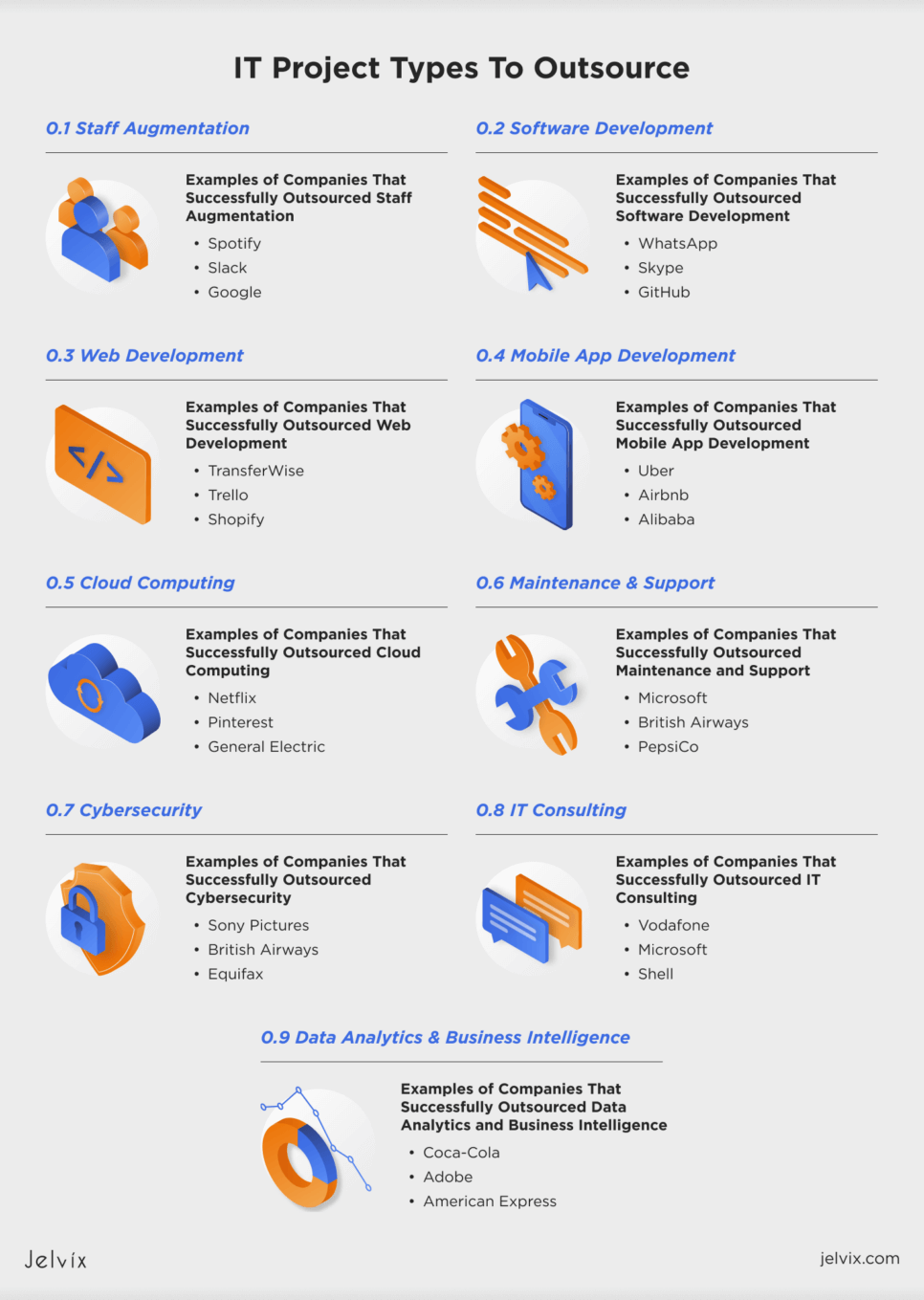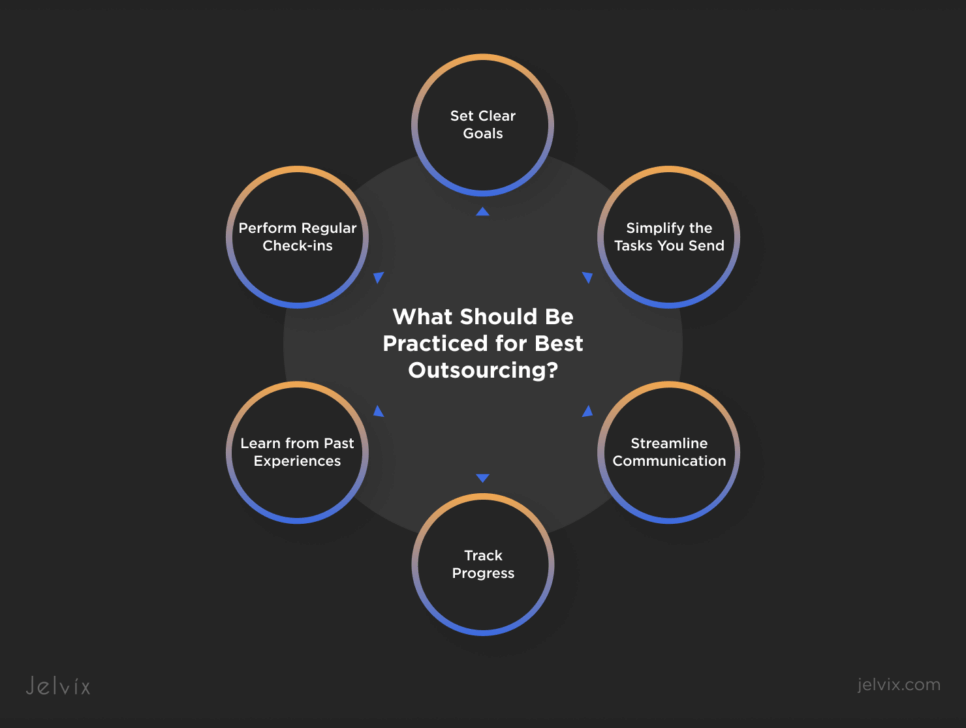In the current business environment, there is a growing trend of outsourcing IT support for business processes, application services, and infrastructure solutions to enhance business results. IT outsourcing enables companies to lower expenses, speed up product launches, and tap into expertise and resources that are not available internally. It is anticipated that the worldwide IT outsourcing sector will increase in size in 2024, reaching an estimated market worth of USD80.7 billion by 2028.
There is a wide variety of IT projects suitable for outsourcing, and each method has its own benefits. In this piece, we will explore various types of IT projects that are commonly contracted out, enabling you to determine which option suits you the most.
What Is IT Project Outsourcing?
Outsourcing an IT project involves assigning a full software development project to another company. Companies typically opt for a fixed-price model when outsourcing. This enables businesses to reallocate resources to different areas as the IT project is being managed externally. Outsourcing not only maximizes resource utilization but also frequently results in more effective software solutions.
Benefits of Outsourcing IT Projects
Below are a few of the key advantages of contracting out IT tasks:
- Businesses can lower capital and labor expenses by outsourcing IT operations instead of handling them internally;
- Having access to specialized knowledge and advanced technology also provides a critical benefit;
- Outsourcing enables companies to concentrate on their main tasks;
- Outsourcing offers the potential for growth and adaptability.
IT Project Outsourcing in Various Industries
Finance
Global digitalization significantly affects financial institutions, and they often turn to IT outsourcing solutions. Organizations typically delegate various technological processes, such as software development or infrastructure maintenance and management, to external service providers.
Healthcare
The healthcare sector often faces the challenges of implementing the latest technologies. Given its specific nature, the industry frequently needs more internal IT resources. Typically, contracts are concluded to provide CRM portals, EMR and EHR platforms, data warehouses, legacy software upgrades, and telemedicine applications.
Retail
Retail, too, relies heavily on adopting the latest technologies to remain competitive. Predictive analytics enables data-based decision-making, and dedicated ERP and CRM systems improve operational management. IT outsourcing is often used to deliver such advanced features as AI-powered personalization, robotic delivery, and cashless checkouts.
Manufacturing
The manufacturing industry is no exception to the involvement of IT outsourcing and is increasingly using this approach to improve efficiency and innovation. For example, outsourcing can provide real-time data analytics for better decision-making, improve supply chain management with cloud-based solutions, and increase product quality with the newest manufacturing technologies.
Education
Educational institutions also require advanced IT outsourcing solutions in today’s dynamic environment. The outburst of the COVID-19 pandemic, among several other factors, has made people turn to education online. The companies are outsourcing the development of solutions for remote educational courses, employee training, and more. The sector can benefit from easy-to-navigate audio and video conferencing and language applications.
IT Project Types To Outsource
#1. Staff Augmentation
Staff augmentation is an engagement model that implies the use of external talents temporarily to expand teams and close the existing skill gaps. For example, you may require a few additional people or a specific talent your in-house team needs for your software development project. You might also need to close the gap in your resources quickly but don’t want to spend time on a lengthy recruitment process.
The main benefits of staff augmentation outsourcing are:
- When hiring external specialists, the client retains complete control over the team;
- Rapid onboarding is critical in staff augmentation, and specialists usually join the project almost immediately after the client interviews and approves them;
- Staff augmentation is perfect for short-term projects.
Here are some examples of successful outsourcing of staff augmentation projects:
- Spotify, the music streaming giant, leveraged staff augmentation to speed up its agile development processes. In doing so, Spotify was able to scale its engineering teams rapidly and address critical talent shortages.
- Slack, a popular business communication platform, faced challenges managing its growing user base. Slack increased its staff by bringing in skilled external support specialists, which has helped maintain high customer support standards.
- Google has often utilized staff augmentation to gain flexibility in project development. The company brought specialized knowledge and skills to various projects, particularly AI and machine learning.
#2. Software Development
Software development outsourcing is when you transfer the development and support of software applications (coding, testing, debugging, etc.) to an external company.
The main benefits of software development outsourcing are:
- Outsourcing allows you to bring in specialists for niche technologies or domains;
- Skilled developers can often be found in regions with lower wages and operating costs;
- Projects can be completed faster, bringing your product to market faster.
Here are some examples of successful outsourcing of software development projects:
- In its early stages, WhatsApp outsourced software development. This strategy allowed WhatsApp to focus on core functionalities and rapid user growth while minimizing expenses.
- Skype outsourced its initial product development to a team of developers from Estonia. This move allowed Skype to use high-quality technical expertise at a lower cost, contributing to its early success and widespread adoption.
- GitHub outsourced the development of several features to external developers. This strategy allowed GitHub to introduce new features faster and with more innovation.
#3. Web Development
Outsourcing web development is when companies delegate the task of managing web development by hiring an external vendor while retaining control over the project. Vendors assist at all stages, from design development and conceptualization to pre-launch testing and maintenance.
The main benefits of web development outsourcing are:
- Companies reduce training, hiring, operations, and development costs;
- Getting a web product to market quickly can provide a competitive advantage;
- Access to experts with specialized IT knowledge, technology stacks, and experience worldwide;
- The IT market offers many web development companies specializing in full-cycle product development.
Here are some examples of successful outsourcing of web development projects:
- TransferWise outsourced the redesigning of its main website. An external web development agency implemented a modern and user-friendly design for TransferWise.
- Trello outsourced the development of its website. Through the expertise of a dedicated web development team, Trello created a responsive and visually appealing site.
- Shopify often outsources the development of themes and templates to third-party developers. This strategy allows Shopify to offer users various customizable themes, enhancing the platform’s flexibility.
#4. Mobile App Development
Mobile application development outsourcing is when external developers or development teams create mobile applications. Businesses can continue to do their core activities and leave the creation of mobile applications to experts.
The main benefits of mobile app development outsourcing are:
- Getting new mobile apps to market just a few weeks or even days earlier can make a big difference due to the rapid changes in the industry;
- Using app development companies opens up opportunities to build flexibility into your projects;
- Available long-term business support in related areas, including market research, marketing, business analytics, and technical maintenance.
Here are some examples of successful outsourcing of mobile app development projects:
- Uber outsourced the development of its initial mobile app to a team of developers in Mexico. This decision allowed Uber to develop a robust, user-friendly app that led to rapid market entry and growth.
- Airbnb outsourced the scaling of its mobile app to handle increased user demand. By working with specialized mobile developers, Airbnb’s app could support a growing number of users while maintaining a smooth experience.
- Alibaba outsourced parts of its mobile commerce app development to international developers. This approach helped Alibaba ensure its app was optimized for different markets, enhancing user experience and driving global expansion.
#5. Cloud Computing
Outsourcing projects for cloud computing involve third-party vendors who supply and oversee cloud infrastructure, platforms, or software. The goal is to implement the newest technology offered by cloud providers and guarantee secure data management, allowing businesses to concentrate on their main objectives.
The main benefits of cloud computing outsourcing are:
- Access to cutting-edge cloud technologies;
- Vast storage capacities offered by cloud service providers;
- Backup options for potential live production data problems;
- Decrease in expenses related to infrastructure.
Here are some examples of successful outsourcing of cloud computing projects:
- Netflix delegated its cloud computing responsibilities to Amazon Web Services (AWS). By doing this, Netflix could concentrate on creating content and improving customer satisfaction while AWS handled the infrastructure.
- Pinterest also enlisted the help of AWS to manage its cloud infrastructure in order to accommodate the increasing number of users and data needs. Transitioning to AWS enabled Pinterest to attain improved flexibility, scalability, and cost-effectiveness.
- General Electric (GE) contracted Microsoft Azure to handle its cloud computing as a component of its digital transformation plan. Azure gave GE a flexible cloud platform to support its Industrial Internet apps, leading to improved efficiency in its worldwide business activities.
#6. Maintenance and Support
These projects require the hiring of external service providers to handle maintenance and support duties. A third-party supplier takes on the responsibility of organizing, arranging, and carrying out maintenance tasks.
The main benefits of maintenance and support outsourcing are:
- Outsourcing maintenance and support provides the ability to control costs in a flexible manner;
- Organizations now have access to maintenance strategic expertise they were previously missing;
- Assigning different everyday duties like overseeing stock, contacting vendors, and doing regular upkeep and fixes.
Here are some examples of successful outsourcing of support and maintenance projects:
- Microsoft delegated some of its customer support responsibilities to external service providers to manage inquiries. By taking this action, Microsoft was able to provide 24/7 support across different time zones, ensuring quick resolution of customer issues.
- British Airways delegated the maintenance of its IT infrastructure to Tata Consultancy Services. This collaboration enabled British Airways to ensure the dependability of its crucial systems, decrease operational expenses, and enhance service levels.
- PepsiCo delegated the maintenance of its IT systems to Cognizant. This collaboration helped PepsiCo maintain the constant and effective functioning of its IT infrastructure, decrease downtime, and enhance system performance.
#7. Cybersecurity
Cybersecurity outsourcing occurs when a company collaborates with a security service provider to manage different cybersecurity tasks. These aspects include risk evaluation, vulnerability testing, monitoring for threats, responding to incidents, and creating security strategies. The scope of IT outsourcing services can differ based on the provider and the unique requirements of the organization.
The main benefits of cybersecurity outsourcing are:
- Access to advanced expertise and up-to-date cybersecurity technologies;
- Outsourcing cybersecurity offers a more cost-effective solution;
- Outsourced services typically provide the ability to adjust scale according to the cybersecurity changing requirements.
Here are some examples of successful outsourcing of cybersecurity projects:
- Following the cyberattack in 2014, Sony Pictures hired FireEye’s Mandiant division to handle its cybersecurity incident response. This collaboration played a crucial role in rebuilding Sony Pictures’ operational and security trust.
- IBM was hired by British Airways to handle its cybersecurity operations. IBM offered ongoing monitoring, advanced threat intelligence, and fast incident response to safeguard British Airways’ critical information and systems.
- After the major data breach in 2017, Equifax enlisted the help of numerous third-party providers for their cybersecurity efforts. These suppliers assisted Equifax in enhancing its security infrastructure, vulnerability management, and threat detection and response.
#8. IT Consulting
In IT consulting outsourcing, a third-party consulting firm offers guidance on IT technologies, cost reduction, efficiency enhancements, automation, enterprise-level systems, and IT audits.
The main benefits of IT consulting outsourcing are:
- Reducing costs through the removal of in-house resources and infrastructure;
- Accessing a diverse group of IT consultants with unique expertise from around the world;
- Businesses can prioritize their main operations as specialists manage intricate IT difficulties.
Here are some examples of successful outsourcing of IT consulting projects:
- Vodafone teamed up with Infosys for consultancy services in order to update its IT structure and propel digital evolution.
- Accenture’s consulting services supported Microsoft in expanding its cloud services and speeding up digital transformation efforts.
- Shell collaborated with Capgemini to modernize its IT infrastructure and drive digital transformation. Capgemini offered consulting services to update Shell’s IT systems, introduce advanced analytics, and improve digital capabilities.
#9. Data Analytics and Business Intelligence
This form of outsourcing entails enlisting external specialists to handle data analysis and business intelligence assignments. This frequently involves analyzing extensive datasets, extracting valuable information, and producing reports to assist companies in making educated choices.
The main benefits of data analytics and business intelligence outsourcing are:
- Significant cost savings are achieved by eliminating the requirement for internal data analysts and tools;
- Accessing advanced skills and technology for enhanced decision-making;
- Expanding analytical capabilities without being limited by a lack of internal resources.
Here are some examples of successful outsourcing of data analytics and business intelligence projects:
- Coca-Cola decided to subcontract its data analytics to Cognizant in order to enhance its marketing tactics. The collaboration resulted in more focused marketing campaigns and improved allocation of marketing budget.
- Adobe engaged Toptal for data analytics and business intelligence services. This partnership enabled Adobe to leverage top talent for data-driven decision-making and optimize its product development strategies.
- American Express worked with Capgemini to outsource its business intelligence functions. This collaboration helped American Express gain deeper insights into customer behavior and improve its service offerings.
Outsourcing IT Projects in Various Stages
Outsourcing IT projects is a complex and multistage process. Here are the main stages of outsourced software development:
Initial project planning and feasibility studies: This stage is about defining the project’s scope, objectives, and requirements. Feasibility studies are conducted to assess the outsourcing project’s viability and potential risks.
Development and implementation: Once planning is complete, the actual development begins. This phase includes coding, integrating systems, and implementing the designed solutions.
Testing and quality assurance: After development, the software undergoes testing to identify and fix bugs. Quality assurance ensures that the product meets all specified requirements and functions correctly.
Post-deployment support and maintenance: Once the software is deployed, ongoing support and maintenance are provided to address any issues, make updates, and ensure the system remains efficient and effective.
Unlock business growth with the right IT partner —streamline operations, enhance scalability, and stay ahead in the digital era.
What Should Be Practiced for Best Outsourcing?
Below, we outline several key strategies for effective outsourcing of IT projects:
#1. Set Clear Goals
Clear goals can help any IT project. It is vital to set out and communicate to the project team clear key performance indicators and measurable objectives.
#2. Track Progress
Once you set your goals, track your progress regularly, whether it’s every two weeks, every month, or every quarter. Communicating the outcomes against the set objectives creates a feedback loop that involves everyone.
#3. Perform Regular Check-ins
Check in with your outsourced IT team. Whether you hold regular one-on-ones or team meetings, encourage active listening by ensuring everyone can voice concerns and ideas. With regular updates and check-ins, you and the external IT team can review progress, discuss issues, and plan the next steps.
#4. Streamline Communication
Place one person in charge of the communication process to ensure messages are clear. In some cases, disputes or challenges may arise. This is why you need escalation and dispute management processes in place. After every meeting or stand-up, write everything down, email your team, and ask if any questions or areas need clarification.
#5. Simplify the Tasks You Send
By sending a massive project document to your outsourced IT team, the likely result is confusion. They may need help determining which aspect is a high priority, or you may have yet to consider language barriers, meaning the complexity will likely cause a greater misinterpretation. Break up tasks and make them smaller and more manageable.
#6. Learn from Past Experiences
IT project success is often achieved when we avoid repeating past mistakes. Use communication channels and protocols to invite your team to analyze what worked well and what didn’t regarding communication and the specific project outcomes. Knowledge sharing is essential, and by carrying out post-project reviews, you’ll have the chance to share experiences and learnings.
Learn how to create a software requirements specification document to bring financial and tech goals together.
Conclusion
In summary, IT project outsourcing offers numerous advantages, such as cost reduction, access to specialized expertise, and the ability to focus on core business activities. Various industries are using IT outsourcing to improve operations and remain competitive in a rapidly evolving digital environment. Understanding the specifics of possible types of outsourcing is important for the effective implementation of such projects.
If you are considering strategic development and need professionals to assess your company’s outsourcing needs, contact the Jelvix Team.
FAQ
How can I choose the best outsourcing partner for my IT project?
You need to perform thorough research to find the right outsourcing partner. Look for partners with a strong track record, positive client testimonials, and relevant industry experience.
How can I maintain quality and standards in outsourced IT projects?
Ensuring quality in outsourced IT projects involves clear communication and explicit project requirements. Use detailed contracts and SLAs to set expectations. Regularly monitor progress through updates and reviews and employ quality assurance practices like code reviews and testing. Continuous feedback loops are essential for addressing issues promptly.
Can outsourcing IT projects help me scale my business operations?
Yes, outsourcing can significantly aid in scaling operations. It provides expertise and access to additional resources without substantial investments in infrastructure and personnel. Businesses can quickly adapt to market demands and expand their capabilities while maintaining cost efficiency.
What are the advantages and disadvantages of outsourcing IT projects?
The advantages of outsourcing IT projects include cost savings, access to specialized skills, focus on core business activities, and enhanced flexibility. However, disadvantages include communication barriers, data security risks, cultural differences, and dependency on the outsourcing partner’s reliability and performance.
What challenges might I face when outsourcing IT projects?
Common challenges include managing communication across time zones, ensuring data security and compliance, maintaining project control, and handling cultural differences. It can also be challenging to make sure that your business needs are understood correctly.
Need a qualified team?
Contact us and build your dedicated development team at ease!


